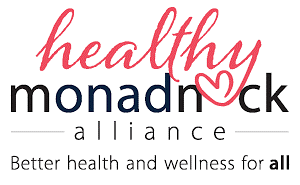Healthy Monadnock Alliance
- Need: Improved health outcomes for Monadnock Region, a rural area of New Hampshire.
- Intervention: A wide-scale effort across multiple sectors is aiming to improve health outcomes throughout the region.
- Results: Community health trends have been tracked over time, and progress on goals such as increasing the number of residents with healthcare coverage, opportunities for physical activity, access to healthy foods, and smoking cessation has been made.
Description
The Monadnock Region is made up of 32 primarily rural towns and one city that surround Mt. Monadnock in the southwest part of New Hampshire. It includes all of Cheshire County, a county that currently ranks at or below average on their health outcomes.
Healthy Monadnock Alliance began in 2007 as a community health initiative when Cheshire Medical Center Dartmouth-Hitchcock posed a challenge to Cheshire County leaders to make the Monadnock Region the "healthiest community in the nation" by the year 2020. In 2020 the Leadership Council for a Healthy Monadnock, who oversees the initiative, reevaluated the mission, knowing their health improvement efforts would continue far past 2020. This resulted in the formation of an Alliance and an updated mission, "Better health and wellness for all," which represents the focus to address disparities, equity, and trauma.
 The vision became a framework that the
Leadership Council for a Healthy Monadnock, a
multi-sector group that oversees a network of
organizations, built upon to develop the
Monadnock Community Health Improvement Plan, revised
in July of 2020. The Council started by defining goals
and researching evidence-based strategies that would help
make the Monadnock Region a place that makes the healthy
choice the easy choice.
The vision became a framework that the
Leadership Council for a Healthy Monadnock, a
multi-sector group that oversees a network of
organizations, built upon to develop the
Monadnock Community Health Improvement Plan, revised
in July of 2020. The Council started by defining goals
and researching evidence-based strategies that would help
make the Monadnock Region a place that makes the healthy
choice the easy choice.
The Alliance spreads across all sectors in the Monadnock Region, engaging many members in collaboration around the mission. Members include employers, schools, coalitions, nonprofits, and local government groups that bring knowledge and expertise on different areas of health and wellness. The effort has become a source of information and encouragement for community stakeholders to take preventive action through environmental, social, and policy changes and to promote the efforts of the Healthy Monadnock Alliance to their stakeholders.
Healthy Monadnock Alliance was developed and is funded primarily by the Cheshire Medical Center Dartmouth-Hitchcock, and is supported by the New Hampshire Department of Health and Human Services as the recognized Regional Public Health Network for the Greater Monadnock Region. Supplemental funding comes from private and public sources.

Services offered
In order to advance their mission, the Leadership Council for Healthy Monadnock updated their Community Health Improvement Plan in 2020 and selected 5 priority issues to focus their efforts. The social drivers of health, equity, and trauma are addressed within each priority area:
- Behavioral Health
- Emergency Preparedness
- Food Access and Healthy Living
- Healthcare Access
- Protective Factors and Risk Factors
Some examples of community programs that support these strategies include:
- The Run and Read project provides age-appropriate books for children and families across the Monadnock region. Through the partnership of the Keene Elm City Rotary Club and the Advocates for Healthy Youth (AFHY) coalition, Run and Read has donated more than 800 books each year to local community sites since its start in 2014.
- Veterans Appreciation thanks veterans living in the Monadnock Region for their service by providing them with vouchers to purchase local food directly from the growers at local Farmers Markets during the month of September, which is Hunger Awareness Month.
- Building Resilience Against Climate Effects (BRACE) which is dedicated to helping individuals in the region prepare for natural disasters.
- Volunteer Driver program which aims to increase the number of volunteer drivers to help with the transportation shortage for vulnerable populations in rural areas of the Monadnock region.
- NARCAN training via the Doorway at Cheshire Medical Center and the Greater Monadnock Public Health Network has trained more than 1,500 people in the Monadnock region in the use of NARCAN since 2015.
- GETTING TO 'Y' program gives students the opportunity to bring meaning to their own Youth Risk Behavior Survey data through youth leadership, partnerships with adults, action research, and peer and community engagement.
Results
In order to better understand the impact of their work and measure progress toward identified goals, the Healthy Monadnock Alliance collects and analyzes a range of regional health and wellness data related to their programs and initiatives. Community wellness metrics for each of the priority areas set out in the 2020 Community Health Improvement Plan are published online. Each metric tracks certain health trends and indicators over time.
Some notable results include:
- Insurance coverage increased by 7% in Cheshire County, with 93% of residents covered
- Approximately 2,300 residents have received behavioral health education
- 89 secondhand smoke policies and protections have been enacted
- Over 11,000 workers gained access to worksite wellness benefits
- More than 1,500 individuals received emergency preparedness training, including NARCAN training
- 88% of local adults reported experiencing good or better health, an increase of 5.5%
Challenges
There were many barriers noted by the Council at the start and continuation of the Healthy Monadnock Alliance. Below are some challenges and how they have been addressed:
- There was an initial misperception among member organizations that, in order to start an initiative for the Alliance, Cheshire Medical Center Dartmouth-Hitchcock needed to lead it. At the same time, the medical center was hoping other members would start to take initiative. Through redirecting and strategies, the Healthy Monadnock Alliance has become an effort of the whole community, not solely led by the medical center.
- Because environmental change often starts with public policy, Council members have put more effort into changing policy and environmental regulations in order to carry out Health Monadnock Alliance initiatives.
- Traditionally, healthcare is often thought of as confined within the walls of a clinic or hospital. Since conversations around Healthy Monadnock Alliance started, the perception that health and well-being extends to all areas of life has become more widely accepted across businesses and individuals.
- The availability of affordable healthy food has been a challenge for the Monadnock Region. The Council has been working with the Cheshire County Conservation District to connect local producers to distributors in order to improve food access on an institutional level.
Replication
Resources and efforts that may help communities implement similar programs include:
- The Community Health Improvement Plan (CHIP) created by the Leadership Council for a Healthy Monadnock to guide the public health work in the region through the Healthy Monadnock Alliance
- Climate and Health Adaptation Plan, created by the Greater Monadnock Public Health Network
- Cheshire Medical Center Community Health Needs Assessment 2022 and its accompanying Implementation Plan, which summarizes the work of Cheshire Medical Center and the Leadership Council for a Healthy Monadnock through collaborative efforts to assess regional health-related needs
- Building Resilience Against Climate Effects Plan of Action 2019, created by the Greater Monadnock Public Health Network
- A Partnerships, Programs, Policy, System, and Environmental Change (PPPSE) model has informed Healthy Monadnock Alliance's approach to creating large-scale, sustainable change
Contact Information
Maggie Graul, MPH, Population Health Epidemiologist, Cheshire Medical CenterCheshire Medical Center Dartmouth-Hitchcock
603.354.5454
mgraul@cheshire-med.com
Topics
Access
Community engagement and volunteerism
Food security and nutrition
Health disparities
Hospitals
Networking and collaboration
Physical activity
Population health
Social determinants of health
Trauma-informed care
Wellness, health promotion, and disease prevention
States served
New Hampshire
Date added
December 31, 2019
Date updated or reviewed
September 26, 2023
Suggested citation: Rural Health Information Hub, 2023. Healthy Monadnock Alliance [online]. Rural Health Information Hub. Available at: https://www.ruralhealthinfo.org/project-examples/1079 [Accessed 26 April 2024]
Please contact the models and innovations contact directly for the most complete and current information about this program. Summaries of models and innovations are provided by RHIhub for your convenience. The programs described are not endorsed by RHIhub or by the Federal Office of Rural Health Policy. Each rural community should consider whether a particular project or approach is a good match for their community’s needs and capacity. While it is sometimes possible to adapt program components to match your resources, keep in mind that changes to the program design may impact results.
